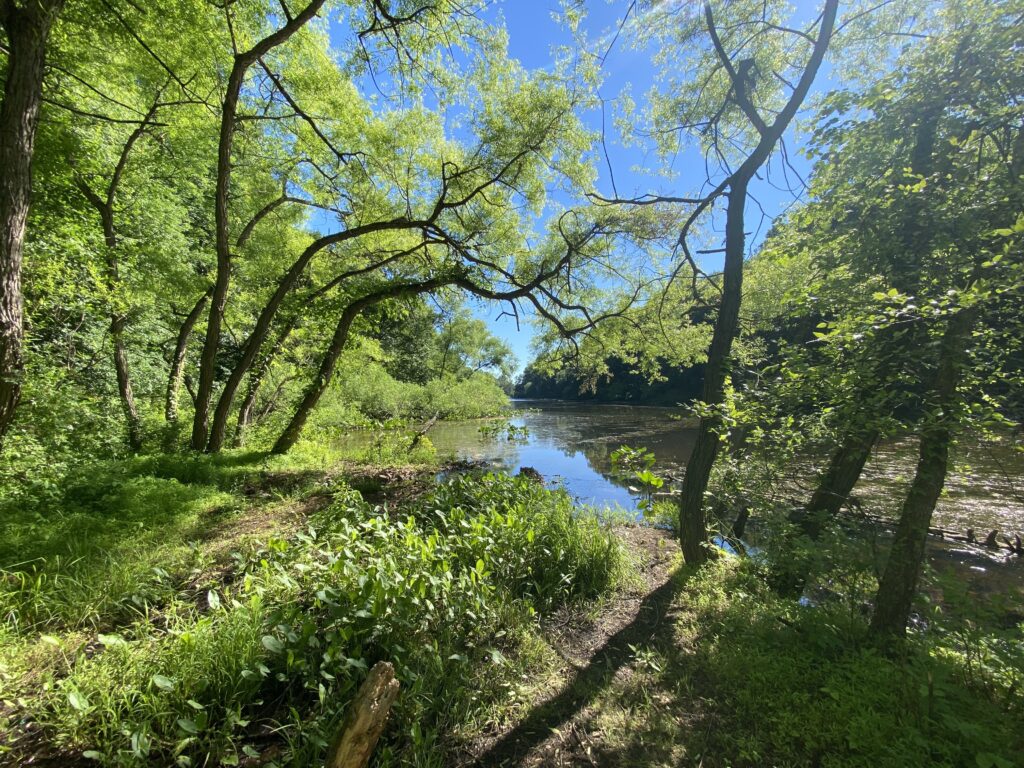Thursday June 24th at 4:00 PM. 73° F with a light breeze and low humidity
The site is muddy near the lake but dry a few feet inland. It is teeming with different plant and insect species. Tall grass grows on the land and water plants with pads similar to water lilies grow up from the water. Seemingly hundreds of dragon flies whiz around, skirting on the water; two dance and fly together. A green moss-like algae spans much of the lake’s surface. In spots near the shore, in direct sunlight, sunfish, trout, and other small fish can be seen. Tiny minnows gather near the surface of a small pool separate from the other fish. The lake bottom and shore is rocky and made up of dirt. Trees rooted in the ground right on the shoreline, lean and bow over the lake. All of the trees lining the shore are the same species with willowy branches and thin leaves. A black and white bird shakes the branches of one of the trees as it flies to and from its perch over the lake. The narrow footpaths are lined with dense ferns about 30 ft from the lake. The paths are heavy with leaf litter. An expanse of small single leaf plants lies in the center of the site from the shore to about 10 ft inland. They look like young water lily-like plants. Some tall flowering plants grow just off the shore in mud, offering blooms and buds in bright yellow. Granite is found on the underside of overturned rocks and a downed tree lays in the lake on the opposite shore. There are small frogs in the shaded mud and a turtle swims slowly through the algae in the center of the lake. Besides the noise pollution from hot heads revving their engines as they speed down the backroads, the only sounds present are the leaves in the wind, the frogs and fish moving in the water, and the birds calling out.

- Why are there so many dragonflies?
- How do they land and stay afloat on the water?
- Do dragonflies “dance”/fly together for mating purposes?
- Why are the trees bowed over the lake?
- How was the lake made (naturally or by man)?
- What type of algae/moss is in the water?
- What other fish species are present?
- Are the fish naturally in the lake or is the lake filled manually with fish every spring?
- Do the larger fish eat the minnows?
- Are the fish drawn to sunny spots or are they the only ones visible because they’re in a sunny spot?
- Why are frogs drawn to mud?
- What specific insects do frogs eat?
- What species of tree are the shoreline trees?
- Why do the tree species on the shore differ from the ones inland 15 feet?
- Why do the trees get shorter/more bowed closer to the lake/further from the forest?
- What type of grass is growing?
- How does the vegetation affect what animals live here?
- What is the species of the lilly pad -like water plants?
- Are the small single leaf plants young water lillies?
- Is there a keystone animal species?
- What does the turtle eat?
- What eats the turtle?
- How has human interaction affected the growth patterns of plants in area?
- How do the plants respond to different climates/conditions like the lake’s water level rising from heavy rainfall?
- Does the breeze shifting the direction of surface water affect any of the marine life?
- How does the path of the sun affect what grows where around the lake?
- How do the insect species interact and coexist?
- What competition occurs between species?
- Why do flies keep landing on me?
- How do terrestrial species interact with the marine species present?
- Why has this sunfish been swimming in circles for 10 minutes?
- How do species and relationships deeper in the forest affect those species and relationships nearer in the lake?
- How does noise pollution from cars affect species interaction?
How was the lake made?
Lake Surprise was previously the Blue Brook. In 1845, David Felt dammed Blue Brook to create a power source for his mill that housed his printing business (ucnj.org). But how was the Blue Brook formed? To get a broader perspective, Lake Surprise is a small lake in the Newark Basin which was formed 225 million to 185 million years ago as North America began to separate from Africa in the supercontinent Pangea (columbia.edu). The basin was filled with sediment and magma erupted three times, creating three layers of volcanic rock which weathered away sediments into the Newark Basin. In the last ice age that reached northern New Jersey, the Wisconsin glacier left behind melt water in the Newark Basin and other lowlands (greatswamp.org). This melt water may have filled the Raritan River as well as its tributaries including Green Brook which Blue Brook is a tributary of. This is a possible geologic history of Blue Brook and Lake Surprise.
I am very intrigued in the specific species that are present at the site, especially the ones I didn’t get a chance to see, and what their ecological roles in the community are. I found the abundant presence of dragonflies very interesting as well as the variation of plant species in the water, on the shoreline, and just a few feet inland.
Hi, this is a comment.
To get started with moderating, editing, and deleting comments, please visit the Comments screen in the dashboard.
Commenter avatars come from Gravatar.